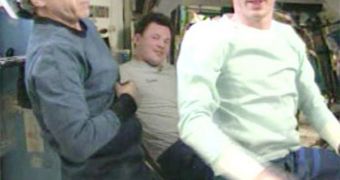Three astronauts landed safely in the steppes of Kazakhstan a bit earlier, having returned from their six-month stays aboard the International Space Station (ISS). RosCosmos cosmonaut Roman Romanenko, European Space Agency (ESA) former ISS Commander Frank DeWinne, and Canadian Space Agency (CSA) astronaut Bob Thirsk descended at their designated location at 07:15 GMT. The time they spent on the station was marked with firsts and new additions, which saw the orbital outpost being 86 percent completed, the BBC News reports.
“We were able to achieve all the goals that we set at the beginning of the mission in terms of science, space operations, education and outreach. With a European astronaut onboard, we can conduct considerably more scientific experiments and increase our ability to exploit the ISS,” explains the ESA director of human spaceflight, Simonetta Di Pippo. The three descend aboard the Soyuz TMA-15 spacecraft, which means that only one other Soyuz lifeboat will be docked at the ISS until December, when three additional crew members are scheduled to complete the crew.
“All three crew members were reported to be in good condition. Due to icy conditions at the landing site, the landing support team recalled its helicopters to their bases in Kustanai and Arkalyk, Kazakhstan. Instead the team arrived in all-terrain vehicles from nearby Arkalyk to extract the Expedition 21 crew members from the Soyuz crew module. Unless weather conditions improve, the crew will make the 50-mile journey back to Arkalyk by land,” says a press release on NASA's website.
Though it may seem like a paradox, as soon as the Soyuz space capsule departed the ISS, and only two astronauts remained, Expedition 21 officially ended, and Expedition 22 began. Only Commander Jeffrey N. Williams (NASA) and flight engineer Maksim Surayev (RosCosmos) are left on the station now, and they will be all alone until the end of December, when the rest of the crew joins them. The other three astronauts are scheduled to be delivered aboard the Soyuz TMA-17 spacecraft, which will mark the 104th flight of this type of capsule.
RosCosmos cosmonaut Oleg Kotov will be the Commander of Expedition 22, and he will be joined in the new flight by NASA astronaut Timothy Creamer, and JAXA astronaut Soichi Noguchi. The last will be the second long-term space flier that the Japanese Space Agency will have on the outpost, after Koichi Wakata, who stayed on the station for Expeditions 18, 19 and 20. The three are scheduled to be launched from the Baikonur Cosmodrome, in Kazakhstan, on December 21.
"I miss my family most of all, of course. I am already dreaming of those first hugs when I see my family in Moscow. After that is nature. I miss the wind; I miss the sunlight, the smell of flowers, and freshly cut grass,” Thirsk stated last week. “I really appreciate my friends. We had a very good time together, we had a very good experience during our six-month flight,” Romanenko said of the astronauts with whom he shared all of his time on the station for the past few months. “The most exciting moment was the arrival of the HTV Japanese cargo vehicle. That went off perfectly,” Thirsk added.
"Romanenko, De Winne and Thirsk spent 188 days in space, 186 of those aboard the orbiting International Space Station. The three arrived at the station in May as part of Expedition 20, which marked the start of six-person crew operations aboard the station. With their arrival, all five of the international partner agencies – NASA, the Russian Federal Space Agency (Roscosmos), the Japan Aerospace Exploration Agency (JAXA), the European Space Agency (ESA) and the Canadian Space Agency (CSA) – were represented on orbit for the first time," the NASA statement says.

 14 DAY TRIAL //
14 DAY TRIAL //